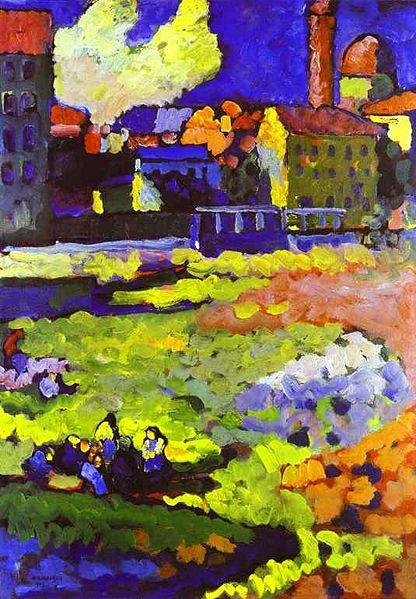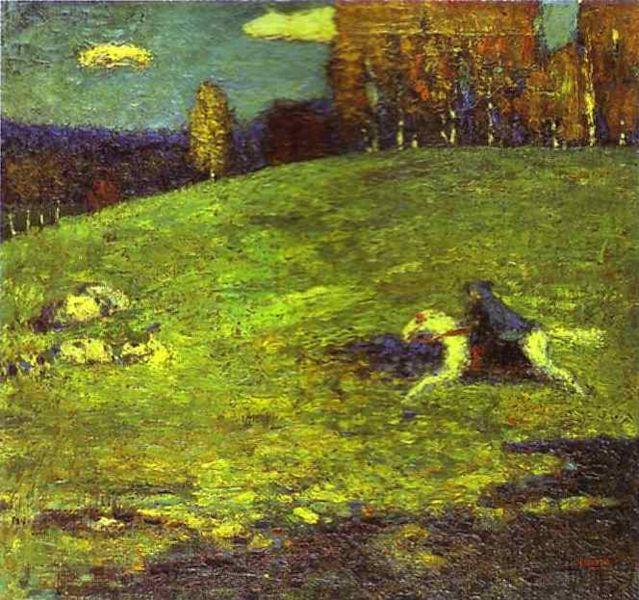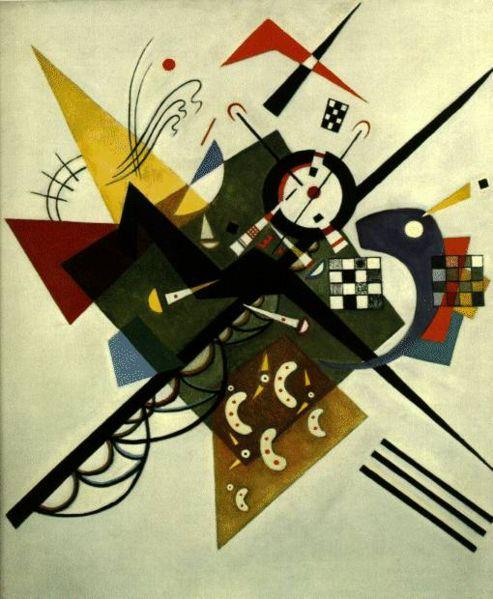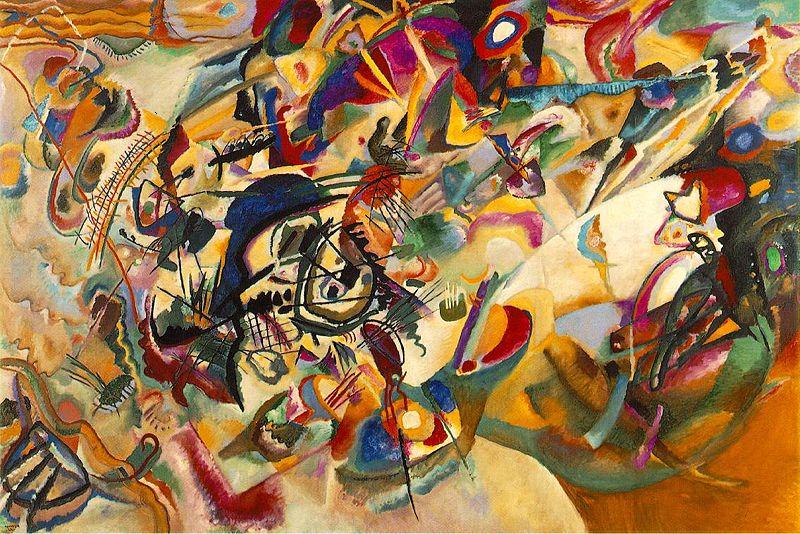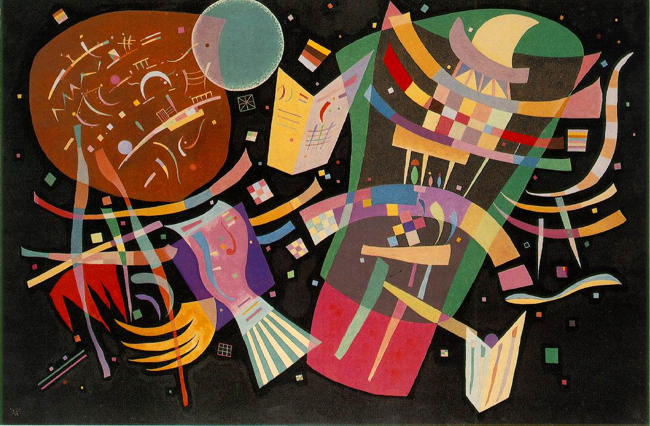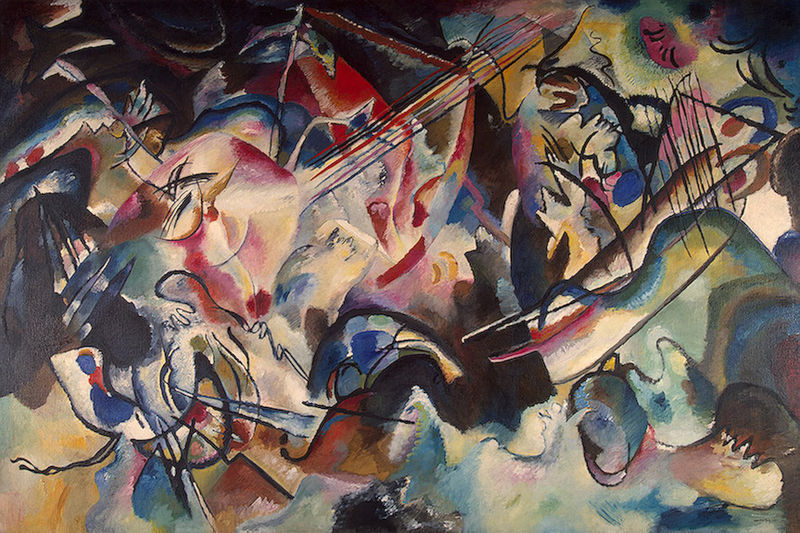<Back to Index>
- Physicist Orest Danilovich Khvolson, 1852
- Painter Wassily Wassilyevich Kandinsky, 1866
- Dictator of Spain Francisco Paulino Hermenegildo Teódulo de Franco y Bahamonde, 1892
PAGE SPONSOR
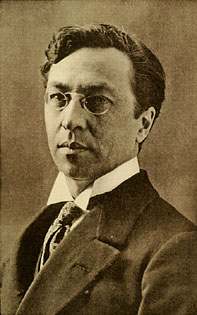
Wassily Wassilyevich Kandinsky (Russian:Васи́лий Васи́льевич Канди́нский; 4 December 1866 – 13 December 1944) was a Russian painter, and art theorist. He is credited with painting the first modern abstract works.
Born in Moscow, Kandinsky spent his childhood in Odessa. He enrolled at the University of Moscow and chose to study law and economics. Quite successful in his profession — he was offered a professorship (chair of Roman Law) at the University of Dorpat — he started painting studies (life-drawing, sketching and anatomy) at the age of 30.
In 1896, he settled in Munich and studied first in the private school of Anton Ažbe and then at the Academy of Fine Arts, Munich. He went back to Moscow in 1914, after World War I started. He was unsympathetic to the official theories on art in Moscow and returned to Germany in 1921. There, he taught at the Bauhaus school of art and architecture from 1922 until the Nazis closed it in 1933. He then moved to France where he lived the rest of his life, and became a French citizen in 1939. He died at Neuilly-sur-Seine in 1944.
His great-grandson, Anton S. Kandinsky, is also a New York-based artist working in a style called 'Gemism'. Kandinsky's
creation of purely abstract work followed a long period of development
and maturation of intense theoretical thought based on his personal
artistic experiences. He called this devotion to inner beauty, fervor of spirit, and deep spiritual desire inner necessity, which was a central aspect of his art. Kandinsky
learned from a variety of life sources in Moscow. Later in his life, he
would recall being fascinated and unusually stimulated by colour as a
child. The fascination with colour symbolism and psychology continued
as he grew. In 1889 he was part of an ethnographic research group that
travelled to the Vologda region north of Moscow. In Looks on the Past he
relates that the houses and churches were decorated with such
shimmering colours that, upon entering them, he had the impression that
he was moving into a painting. The experience and his study of the folk
art in the region, in particular the use of bright colours on a dark
background, was reflected in much his early work. A few years later, he
first related the act of painting to creating music in the manner for
which he would later become noted and wrote, "Colour is the keyboard,
the eyes are the harmonies, the soul is the piano with many strings.
The artist is the hand that plays, touching one key or another, to
cause vibrations in the soul." It
was not until 1896, at the age of 30, that Kandinsky gave up a
promising career teaching law and economics to enroll in art school in
Munich. He was not immediately granted admission in Munich and began
learning art on his own. Also in 1896, prior to leaving Moscow, he saw
an exhibit of paintings by Monet and was particularly taken with the famous impressionistic Haystacks which, to him, had a powerful sense of colour almost independent of the
objects themselves. Later he would write about this experience: He was similarly influenced during this period by Richard Wagner's Lohengrin which, he felt, pushed the limits of music and melody beyond standard lyricism. Kandinsky was also spiritually influenced by H. P. Blavatsky (1831 – 1891), the most important exponent of Theosophy in
modern times. Theosophical theory postulates that creation is a
geometrical progression, beginning with a single point. The creative
aspect of the forms is expressed by the descending series of circles,
triangles, and squares. Kandinsky's book Concerning the Spiritual In Art (1910) and Point and Line to Plane (1926) echoed this basic Theosophical tenet. Kandinsky's
time at art school, typically considered difficult to get through, was
eased by the fact that he was older and more settled than the other
students. It was during this time that he began to emerge as a true art
theorist in addition to being a painter. The number of existing
paintings increased at the beginning of the 20th century
and much remains of the many landscapes and towns that he painted,
using broad swathes of colour but recognizable forms. For the most
part, however, Kandinsky's paintings did not emphasize any human
figures. An exception is Sunday, Old Russia (1904) where Kandinsky recreates a highly colourful (and fanciful) view of peasants and nobles before the walls of a town. Riding Couple (1907)
depicts a man on horseback, holding a woman with tenderness and care as
they ride past a Russian town with luminous walls across a river. Yet
the horse is muted, while the leaves in the trees, the town, and the
reflections in the river glisten with spots of colour and brightness.
The work shows the influence of pointillism in the way the depth of field is collapsed into a flat luminescent surface. Fauvism is
also apparent in these early works. Colours are used to express the
artist's experience of subject matter, not to describe objective
nature. Perhaps the most important of Kandinsky's paintings from the
first decade of the 1900s was The Blue Rider (1903),
which shows a small cloaked figure on a speeding horse rushing through
a rocky meadow. The rider's cloak is a medium blue, and the shadow cast
is a darker blue. In the foreground are more amorphous blue shadows,
presumably the counterparts of the fall trees in the background. The
Blue Rider in the painting is prominent, but not clearly defined, and
the horse has an unnatural gait (which Kandinsky must have known).
Indeed, some believe that a second figure, a child perhaps, is being
held by the rider, though this could just as easily be another shadow
from a solitary rider. This type of intentional disjunction, allowing
viewers to participate in the creation of the artwork, would become an
increasingly conscious technique used by Kandinsky in subsequent years,
culminating in the (often nominally) abstract works of the 1911 – 1914
period. In The Blue Rider Kandinsky shows the rider more as a series of colours than of specific details. In and of itself, The Blue Rider is
not exceptional in that regard when compared to contemporary painters,
but it does show the direction that Kandinsky would take only a few
years later. From 1906 to 1908 Kandinsky spent a great deal of time travelling across Europe, (he was an associate of the Blue Rose symbolist group of Moscow) until he settled in the small Bavarian town of Murnau. The Blue Mountain (1908 – 1909)
was painted at this time and shows more of his trend towards pure
abstraction. A mountain of blue is flanked by two broad trees, one
yellow and one red. A procession of some sort with three riders and
several others crosses at the bottom. The faces, clothing, and saddles
of the riders are each a single colour, and neither they nor the
walking figures display any real detail. The flat planes and the
contours also are indicative of some influences by the Fauvists. The
broad use of colour in The Blue Mountain,
illustrates Kandinsky's move towards an art in which colour is
presented independently of form, and which each colour is given equal
attention. The composition has also become more planar, as it seems
that the painting itself is divided into four sections - the sky, the
red tree, the yellow tree, and the blue mountain containing the three
riders. The
paintings of this period are composed of large and very expressive
coloured masses evaluated independently from forms and lines which
serve no longer to delimit them but are superimposed and overlap in a
very free way to form paintings of an extraordinary force. The
influence of music has been very important on the birth of abstract
art, as it is abstract by nature — it does not try to represent the
exterior world but rather to express in an immediate way the inner
feelings of the human soul. Kandinsky sometimes used musical terms to
designate his works; he called many of his most spontaneous paintings
"improvisations", while he entitled more elaborated works
"compositions". In
addition to painting Kandinsky developed his voice as an art theorist.
In fact, Kandinsky's influence on the history of Western art stems
perhaps more from his theoretical works than from his paintings. He
helped to found the Neue Künstlervereinigung München (New
Artists' Association) and became its president in 1909. The group was
unable to integrate the more radical approach of those like Kandinsky
with more conventional ideas of art and the group dissolved in late
1911. Kandinsky then moved to form a new group The Blue Rider (Der Blaue Reiter) with like minded artists such as August Macke and Franz Marc. The group released an almanac, called The Blue Rider Almanac, and held two exhibits. More of each were planned, but the outbreak of World War I in 1914 ended these plans and sent Kandinsky home to Russia via Switzerland and Sweden. Kandinsky's writing in The Blue Rider Almanac and the treatise On the Spiritual In Art,
which was released at almost the same time, served as both a defense
and promotion of abstract art, as well as an appraisal that all forms
of art were equally capable of reaching a level of spirituality. He
believed that colour could be used in a painting as something
autonomous and apart from a visual description of an object or other
form. Through
the years 1918 to 1921, Kandinsky dealt with the cultural development
politics of Russia and collaborated in the domains of art pedagogy and
museum reforms. He devoted his time to artistic teaching with a program
based on form and colour analysis, as well as participating in the
organization of the Institute of Artistic Culture in Moscow. He painted
little during this period. In 1916 he met Nina Andreievskaia, who in
the following year became his wife. His spiritual, expressionistic view
of art was ultimately rejected by the more radical members of the
Institute as too individualistic and bourgeois. In 1921 Kandinsky
received the mission to go to Germany to attend the Bauhaus of Weimar, on the invitation of its founder, the architect Walter Gropius. The Bauhaus was an innovative architecture and art school whose objectives included the merging of plastic arts with applied arts,
reflected in its teaching methods based on the theoretical and
practical application of the plastic arts synthesis. Kandinsky taught
the basic design class for beginners and the course on advanced theory,
and also conducted painting classes and a workshop where he completed
his colour theory with new elements of form psychology. The development
of his works on forms study, particularly on point and different forms
of lines, lead to the publication of his second major theoretical book Point and Line to Plane in 1926. Geometrical
elements took on increasing importance in his teaching as well as in
his painting, particularly circle, half-circle, the angle, straight
lines and curves. This period was a period of intense production. The
freedom of which is characterised in each of his works by the treatment
of planes rich in colours and magnificent gradations as in the painting Yellow – red – blue (1925), where Kandinsky shows his distance from constructivism and suprematism movements whose influence was increasing at this time. The large two meter width painting that is Yellow – red – blue consists of a number of main forms: a vertical yellow rectangle, a
slightly inclined red cross and a large dark blue circle, while a
multitude of straight black or sinuous lines, arcs of circles,
monochromatic circles and scattering of coloured checkerboards
contribute to its delicate complexity. This simple visual
identification of forms and of the main coloured masses present on the
canvas only corresponds to a first approach of the inner reality of the
work whose right appreciation necessitates a much deeper
observation — not only of forms and colours involved in the painting, but
also of their relation, their absolute position and their relative
disposition on the canvas, of their whole and reciprocal harmony. Kandinsky was one of Die Blaue Vier (Blue Four), with Klee, Feininger and von Jawlensky formed
in 1923. They lectured and exhibited together in the USA in 1924. In
front of the hostility of the political parties of the right, the
Bauhaus left Weimar and settled in Dessau from
1925. Following a fierce slander campaign from the Nazis, the Bauhaus
closed at Dessau in 1932. The school pursued its activities in Berlin until its dissolution in July 1933. Kandinsky then left Germany and settled in Paris. In
Paris he was quite isolated since abstract painting — particularly
geometric abstract painting — was not recognized, the artistic fashions
being mainly Impressionism and cubism.
Kandinsky lived in a small apartment and created his work in a studio
constructed in the living room. Biomorphic forms with supple and
non-geometric outlines appear in his paintings; forms which suggest
externally microscopic organisms but which always express the artist's
inner life. He used original colour compositions which evoke Slavonic
popular art and which are similar to precious watermark works. He also
occasionally mixed sand with paint to give a granular texture to his
paintings. This
period corresponds, in fact, to a vast synthesis of his previous work,
of which he used all elements, even enriching them. In 1936 and 1939 he
painted his two last major compositions; canvases particularly
elaborate and slowly ripped that he hadn't produced for many years. Composition IX is
a painting with highly contrasted powerful diagonals and whose central
form give the impression of a human embryo in the womb. The small
squares of colours and the coloured bands seem to stand out against the
black background of Composition X, as stars' fragments or filaments, while enigmatic hieroglyphs with pastel tones cover the large maroon mass, which seems to float in the upper left corner of the canvas. In
Kandinsky’s work, some characteristics are obvious while certain
touches are more discrete and veiled; that is to say they reveal
themselves only progressively to those who make the effort to deepen
their connection with his work. He intended his forms, which he subtly
harmonized and placed, to resonate with the observer's own soul.
Writing that "music is the ultimate teacher," Kandinsky embarked upon
the first seven of his ten Compositions. The first three survive only in black-and-white photographs taken by fellow artist and friend, Gabriele Münter. While studies, sketches, and improvisations exist (particularly of Composition II), a Nazi raid on the Bauhaus in the 1930s resulted in the confiscation of Kandinsky's first three Compositions. They were displayed in the State sponsored exhibit "Degenerate Art" then destroyed along with works by Paul Klee, Franz Marc and other modern artists. Influenced by Theosophy and the perception of a coming New Age, a common theme among Kandinsky's first seven Compositions is the Apocalypse, or the end of the world as we know it. Writing of the "artist as prophet" in his book, Concerning the Spiritual In Art,
Kandinsky created paintings in the years immediately preceding World
War I showing a coming cataclysm which would alter individual and
social reality. Raised an Orthodox Christian, Kandinsky drew upon the Jewish and Christian stories of Noah's Ark, Jonah and the whale, Christ's Anastasis and Resurrection, the Four Horsemen of the Apocalypse in the Revelation,
various Russian folk tales, and the common mythological experiences of
death and rebirth. Never attempting to picture any one of these stories
as a narrative, he used their veiled imagery as symbols of the
archetypes of death / rebirth and destruction / creation he felt were
imminent to the pre-World War I world. As he stated in Concerning the Spiritual In Art, Kandinsky felt that an authentic artist creating art from "an
internal necessity" inhabits the tip of an upwards moving triangle.
This progressing triangle is penetrating and proceeding into tomorrow.
Accordingly, what was odd or inconceivable yesterday is commonplace
today; what is avant garde today
(and understood only by the few) is standard tomorrow. The modern
artist / prophet stands lonely at the tip of this triangle making new
discoveries and ushering in tomorrow's reality. Kandinsky had become
aware of recent developments in sciences, as well as the advances of
modern artists who had contributed to radically new ways of seeing and
experiencing the world. Composition IV and
subsequent paintings are primarily concerned with evoking a spiritual
resonance in viewer and artist. As in his painting of the apocalypse by
water (Composition VI), Kandinsky puts the viewer in the
situation of experiencing these epic myths by translating them into
contemporary terms along with requisite senses of desperation, flurry,
urgency, and confusion. This spiritual communion of
viewer - painting - artist / prophet is ineffable but may be described to the
limits of words and images. As the Der Blaue Reiter Almanac essays and theorizing with composer Arnold Schoenberg indicate,
Kandinsky also expressed this communion between artist and viewer as
being simultaneously available to the various sense faculties as well
as to the intellect (synesthesia).
Hearing tones and chords as he painted, Kandinsky theorized that, for
examples, yellow is the colour of middle-C on a piano, a brassy trumpet
blast; black is the colour of closure and the ends of things; and that
combinations and associations of colours produce vibrational
frequencies akin to chords played on a piano. Kandinsky also developed
an intricate theory of geometric figures and their relationships,
claiming, for example, that the circle is the most peaceful shape and
represents the human soul. These theories are set forth in Point and Line to Plane. During the months of studies Kandinsky made in preparation for Composition IV he
became exhausted while working on a painting and went for a walk. In
the meantime, Gabriele Münter tidied his studio and inadvertently
turned his canvas on its side. Upon returning and seeing the canvas — yet
not identifying it — Kandinsky fell to his knees and wept, saying it was
the most beautiful painting he had seen. He had been liberated from
attachment to the object. As when he first viewed Monet's Haystacks, the experience would change his life and the history of Western art. In another event with Münter during the Bavarian Abstract Expressionist years, Kandinsky was working on his Composition VI.
From nearly six months of study and preparation, he had intended the
work to evoke a flood, baptism, destruction, and rebirth
simultaneously. After outlining the work on a mural-sized wood panel,
he became blocked and could not go on. Münter told him that he was
trapped in his intellect and not reaching the true subject of the
picture. She suggested he simply repeat the word "uberflut" ("deluge" or "flood") and focus on its sound rather than its meaning.
Repeating this word like a mantra, Kandinsky painted and completed the
monumental work in only a three-day span.
“ That
it was a haystack the catalogue informed me. I could not recognize it.
This non-recognition was painful to me. I considered that the painter
had no right to paint indistinctly. I dully felt that the object of the
painting was missing. And I noticed with surprise and confusion that
the picture not only gripped me, but impressed itself ineradicably on
my memory. Painting took on a fairy-tale power and splendour. ”
